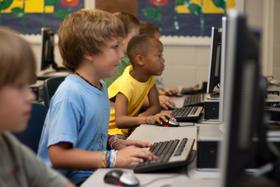The upcoming school year brings a mix of emotions for kids and parents alike – from excitement over the promise of new beginnings to anxiety over the fear of the unknown. No matter how you child faces the new year, you can help him or her to make the most of the experience. These tips help you to help your child start the new school year on the right foot.
Ease into a Schedule
Most children spend their summers staying up late and sleeping in, which can make the adjustment to an earlier school schedule a bit of a shock to the system. Plan for a softer transition by easing children into the school schedule gradually during the last week or two of summer break. By pushing bedtimes up by one-half or one hour each week, your child will be better prepared to meet that first early bell with a smile.
Plan to Eat Right
PBS Parents recommends re-focusing summer eating habits that might have consisted of junk food on the run to healthy sit-down meals as a family whenever possible. When children spend many hours each day in a classroom, they need all the nutrition they can get to keep their brains in top performing condition. Begin with healthy breakfast selections, and try to have family dinner nights as often as possible throughout the week.
Set Up a Homework Station
Homework time will go that much more smoothly if all the necessary supplies are right at hand. Create a corner in the home, whether a desk in the bedroom or a space at the kitchen table, where kids have paper, pencils, erasers and other supplies within easy reach. Once the station is created, use it at the same time every day, establishing a study time after school without any electronic devices unless they are required for the assignment.
Make the Proper Introductions
If your child is apprehensive about the first day, plan to meet with teachers and school staff prior to that event. School Family recommends setting an appointment to meet the school principal, teacher and any support staff your child might come in contact regularly. Simply putting a face to a name can go far in easing a child’s first-day jitters – and a parent’s anxiety as well.
Take a Tour
If your child is starting a new school, a tour of the building will help him or her get the lay of land before that first bell rings. Some schools offer organized tours prior to the start of the year, but if they don’t, call the school and ask if you can schedule one. At the same time, do a practice run or two to and from the school so your child is comfortable with the route, particularly if he will be riding his bike or walking to school on his own.
Get a Handle on the Curriculum
Parents have many sources for learning about the curriculum that will be used in their child’s classroom during the upcoming year. An appointment with the teacher or principal is a good first step for collecting information. Some schools also feature orientation days where curriculum and goals for the classroom are reviewed. If the school doesn’t make the information available, the state department of education will also have curriculum information on their website.
Get Involved
If time allows, plan to get involved in your child’s school experience. Volunteer to help in the classroom, plan a class party or work in the lunchroom one day a week. There are many ways to get involved that allow you to observe your child in the school environment. If you are unable to volunteer, talk to your child every day about the school day and keep lines of communication with the teacher wide open.
Learn the Art of Organization
Older students may need some help in the organization department if they want to be as successful academically as they can be. Create an organizational system for older students that makes it easy for them to track assignments and keep track of papers. Give the system a check-up once a week to ensure clutter doesn’t begin to build up. Clean out backpacks weekly as well to catch stray permission slips and homework assignments before they fall through the cracks.
Teach Good Study Habits
Another important component for success during the later years of school is the development of good study habits. Students need to explore study methods and practices that work for them and then employ those practices throughout the year. The most important fact to drive home is that daily study is much more effective than last-minute cramming – which some strong-willed students may have to learn the hard way.
Keep it Positive
The most important part of preparing for the upcoming school year is to keep a positive attitude about the experience. When parents show a positive attitude towards school and academics in general, students will tend to do so as well. Keep the end goal in sight – the wonderful opportunity to learn new things – and your children will be more likely to embrace the school experience.
Getting ready to go back to school is a major event in most households across the country this time of year. With these tips in mind, parents will be ready to help their students face the challenges, excitement and changes the new school year will bring - and to really put parents' minds at ease, use these 10 signs to know if your child is indeed ready for the new school year.
Questions? Contact us on Twitter. @publicschoolreview















